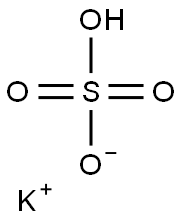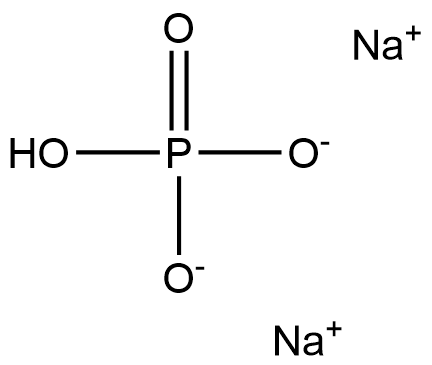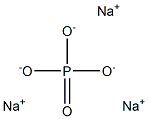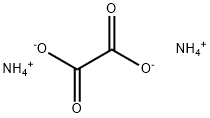Sodium bisulfate
Synonym(s):Sodium bisulfate
- CAS NO.:7681-38-1
- Empirical Formula: NaHSO4
- Molecular Weight: 120.06
- MDL number: MFCD00003531
- EINECS: 231-665-7
- SAFETY DATA SHEET (SDS)
- Update Date: 2025-12-17 09:49:53

What is Sodium bisulfate?
Description
Sodium bisulfate (NaHSO4) is available in anhydrous form and as a monohydrate. Anhydrous sodium bisulfate is hygroscopic. Sodium bisulfate is generally used to adjust the pH of a solution.
Chemical properties
Also known as sodium acid sulfate, niter cake, sodium hydrogen sulfate, NaHS04, is colorless crystals or white fused lumps,whose aqueous solution is strongly acid.It is soluble in water and noncombustible. Derived as a byproduct in the manufacture of hydrochloric acid and nitric acid, it is purified by recrystallization. Used as a flux for decomposing minerals,substitute for sulfuric acid in dyeing,disinfectant, in the manufacture of sodium hydrosulfide,sodium sulfate,and soda slum,for liberating CO2 in carbonic acid baths,in thermophores, for carbonizing wool, in the manufacture of magnesia cements,paper,soap,perfumes, foods, industrial cleaners, metal pickling compounds, and as a lab reagent.
Physical properties
Colorless crystals; triclinic structure; density 2.435g/cm3 at 13°C; melts above 315°C; decomposes on further heating; soluble in water, 28.6 g/100mL at 25°C; highly soluble in boiling water, 100g/100 mL at 100°C; aqueous solution strongly acidic, pH of 0.1 M solution 1.4; insoluble in liquid ammonia; decomposed by alcohol into sodium sulfate and sulfuric acid.
The Uses of Sodium bisulfate
sodium bisulfate is an inorganic salt used as an anti-septic and a pH adjuster in cosmetic creams. Concentrated solutions can produce strong irritation.
The Uses of Sodium bisulfate

The SM (39.4 g, 149.98 mmol) and DIEA (51.69 mL, 300 mmol) were dissolved in THF (550 mL) and stirred at -10 C under N2. Then a solution of isobutylchloroformate in THF (50 mL) was added dropwise and stirring was continued for 1 h at -10 C, then 1 h at RT. NaBH4 (17.02 g, 450 mmol) was added portionwise at -10 C and stirred for 1 h. H2O (200 mL) was added cautiously to the reaction mixture and stirring was continued for another hour at RT under N2. The mixture was neutralized with 10% citric acid (aq) and then was extracted with EtOAc. The org layer was dried (MgSO4) and concentrated. The residue was purified by silica gel chromatography (50:50:0 to 0:100:0 to 0:99:1 heptane/DCM/MeOH) to provide the product as a white powder. [23.9 g, 64%]
The Uses of Sodium bisulfate
Flux for decomposing minerals; substitute for sulfuric acid in dyeing; disinfectant; manufacture of sodium hydrosulfide, sodium sulfate, and soda alum; liberating CO 2 in carbonic acid baths, in thermophores; carbonizing wool; manufacture of magnesia cements, paper, soap, perfumes, foods, industrial cleaners, metal pickling compounds; lab reagent.
The Uses of Sodium bisulfate
Sodium Hydrogen Sulfate is used in production of Nickel Hydroxide Electrode material for Alkaline battery.
General Description
Bisulfate, aqueous solution is a white crystalline solid dissolved in water. Sodium bisulfate is corrosive to metals and tissue.
Air & Water Reactions
Dissolves in water to give strongly acidic solutions.
Reactivity Profile
Acidic salts, such as various BISULFATES, are generally soluble in water. The resulting solutions contain moderate concentrations of hydrogen ions and have pH's of less than 7.0. They react as acids to neutralize bases. These neutralizations generate heat, but less or far less than is generated by neutralization of inorganic acids, inorganic oxoacids, and carboxylic acid. They usually do not react as either oxidizing agents or reducing agents but such behavior is not impossible. Many of these compounds catalyze organic reactions. The combination of calcium hypochlorite, sodium hydrogen sulfate, starch, and sodium carbonate, when compressed, caused the materials to incandescence, followed by explosion, [Ind. Eng. Chem., 1937, 15, 282].
Hazard
Strong irritant to tissue.
Health Hazard
TOXIC; inhalation, ingestion or skin contact with material may cause severe injury or death. Contact with molten substance may cause severe burns to skin and eyes. Avoid any skin contact. Effects of contact or inhalation may be delayed. Fire may produce irritating, corrosive and/or toxic gases. Runoff from fire control or dilution water may be corrosive and/or toxic and cause pollution.
Fire Hazard
Non-combustible, substance itself does not burn but may decompose upon heating to produce corrosive and/or toxic fumes. Some are oxidizers and may ignite combustibles (wood, paper, oil, clothing, etc.). Contact with metals may evolve flammable hydrogen gas. Containers may explode when heated.
Safety Profile
A corrosive irritant to skin, eyes, and mucous membranes. Mutation data reported. Reacts with moisture to form sulfuric acid. Uxtures with calcium hypochlorite + starch + sodium carbonate explode when compressed. Violent reaction with acetic anhydride + ethanol may lead to ignition and a vapor explosion. Incompatible with calcium hypochlorite. When heated to decomposition it emits toxic fumes of SO, and NanO. See also SULFATES.
Properties of Sodium bisulfate
| Melting point: | 315 °C |
| Density | 2.1 |
| form | Granules |
| appearance | White solid (anhydrous) |
| color | White to light yellow |
| Water Solubility | soluble in 2 parts H2O, 1 part boiling H2O; decomposes in alcohol to sodium sulfate and H2SO4 [MER06] |
| Sensitive | Hygroscopic |
| Merck | 13,8658 |
| Stability: | Stable. Incompatible with strong bases, strong oxidizing agents, sodium carbonate, sodium hypochlorite. May decompose upon exposure to moist air or water. |
| InChI | InChI=1S/Na.H2O4S.H/c;1-5(2,3)4;/h;(H2,1,2,3,4); |
| CAS DataBase Reference | 7681-38-1(CAS DataBase Reference) |
| EPA Substance Registry System | Sodium bisulfate (7681-38-1) |
Safety information for Sodium bisulfate
| Signal word | Danger |
| Pictogram(s) |
 Corrosion Corrosives GHS05 |
| GHS Hazard Statements |
H318:Serious eye damage/eye irritation |
| Precautionary Statement Codes |
P280:Wear protective gloves/protective clothing/eye protection/face protection. P305+P351+P338:IF IN EYES: Rinse cautiously with water for several minutes. Remove contact lenses, if present and easy to do. Continuerinsing. |
Computed Descriptors for Sodium bisulfate
| InChIKey | TTXJTWGBBUPRBF-UHFFFAOYSA-N |
| SMILES | S(O)(O)(=O)=O.[NaH] |
Sodium bisulfate manufacturer
ASM Organics
New Products
Indole Methyl Resin tert-butyl 9-methoxy-3-azaspiro[5.5]undecane-3-carboxylate Boc-His(Boc)-OH 2-CTC Resin 4-Chloro-7-tosy1-7Hpyrrolo[2,3-d]pyrimidine 5,7-Dibromo-1H-indole 2,5-dichloro-N-hydroxy-4,6-dimethylpyridine-3-carboximidamide 2,2-Dimethoxy-7-azaspiro[3.5]nonane hydrochloride 4-chloromethyl-5-methyl-1,3-dioxol-2-one (DMDO-Cl) R-2-BENZYLOXY PROPIONIC ACID 1,1’-CARBONYLDIIMIDAZOLE 1,1’-CARBONYLDI (1,2-4 TRIAZOLE) N-METHYL INDAZOLE-3-CARBOXYLIC ACID 4-((2-hydroxyethyl)thio)benzoic acid 1-(TERT-BUTOXYCARBONYL)-2-PYRROLIDINONE Methyl 6-methylnicotinate 3-Pyridineacrylic acid tert-Butyl carbazate TETRAHYDRO-2H-PYRAN-3-OL 2-((4-morpholinophenylamino) (methylthio) methylene) malononitrile 3-(4-morpholinophenylamino)-5-amino-1H-pyrazole-4-carbonitrile 2,4-dihydroxybenzaldehyde 1,3-Diethyl-1,3-Diphenylurea Methyl 2-methylquinoline-6-carboxylateRelated products of tetrahydrofuran








You may like
-
 Sodium Bi Sulphate 99%View Details
Sodium Bi Sulphate 99%View Details -
 SODIUM BISULPHATE 98%View Details
SODIUM BISULPHATE 98%View Details -
 Sodium hydrogen sulfate 98%View Details
Sodium hydrogen sulfate 98%View Details -
 Sodium hydrogen sulfate 99%View Details
Sodium hydrogen sulfate 99%View Details -
 Sodium hydrogen sulfate CAS 7681-38-1View Details
Sodium hydrogen sulfate CAS 7681-38-1View Details
7681-38-1 -
 Sodium bisulfate 92% CAS 7681-38-1View Details
Sodium bisulfate 92% CAS 7681-38-1View Details
7681-38-1 -
 Sodium BisulphateView Details
Sodium BisulphateView Details
7681-38-1 -
 Sodium Bisulphate (Powder), 50 Kg Bag, IndustrialView Details
Sodium Bisulphate (Powder), 50 Kg Bag, IndustrialView Details
7681-38-1
